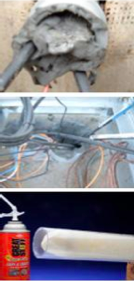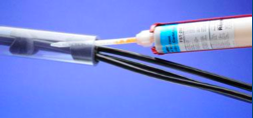 Know the Code NFPA 70® National Electrical Code® 2011 Edition
Know the Code NFPA 70® National Electrical Code® 2011 Edition
The NEC states that conduits and raceways should be sealed to prevent moisture, hazardous gases and vapors from entering buildings. It also requires sealants to be compatible with cable jackets and other components as referenced in the sections below.
* 225.27 Raceway Seal. Where a raceway enters a building or structure from an underground distribution system, it shall be sealed in accordance with 300.5(G). Spare or unused raceways shall also be sealed. Sealants shall be identified for use with the cable insulation, shield, or other components.
* 230.8 Raceway Seal. Where a service raceway enters a building or structure from an underground distribution system, it shall be sealed in accordance with 300.5(G). Spare or unused raceways shall also be sealed. Sealants shall be identified for use with the cable insulation, shield, or other components.
* 300.5(G) Raceway Seals. Conduits or raceways through which moisture may contact live parts shall be sealed or plugged at either or both ends. Informational Note: Presence of hazardous gases or vapors may also necessitate sealing of underground conduits or raceways entering buildings.
 Polywater® FSTTM Foam Duct Sealant meets and exceeds the NEC section requirements for sealing conduit systems. Polywater® FSTTM is superior to both duct putty and aerosol cans of foam because it has been tested for cable compatibility; holds 22 feet of water head pressure continuously and up to 90 feet intermittently; prevents gas from passing through; does not sag; will not dry out; and is re-enterable. FSTTM sealant is chemically resistant to gasoline, oils, dilute acids and bases, and most unsaturated hydrocarbons.
Polywater® FSTTM Foam Duct Sealant meets and exceeds the NEC section requirements for sealing conduit systems. Polywater® FSTTM is superior to both duct putty and aerosol cans of foam because it has been tested for cable compatibility; holds 22 feet of water head pressure continuously and up to 90 feet intermittently; prevents gas from passing through; does not sag; will not dry out; and is re-enterable. FSTTM sealant is chemically resistant to gasoline, oils, dilute acids and bases, and most unsaturated hydrocarbons.
The most widely used product to seal conduits is duct putty. Duct putty is intended to seal around junction boxes and flashings. When used in conduits it sags over tine and creates openings in seals when cables and wires move. Putty holds minimal water head pressure, compresses under large cable weight and typically had no test reports showing cable jacket compatibility. Bottom line is duct putty fails.
Canned foam is designed for crack and crevices. It creates a lightweight, open-cell structure that allows water and moisture to pass through, much like a sponge. It doesn’t fully cure in thick layers or enclosed spaces. Its seal is not airtight or watertight. Bottom line is canned foam fails.
Neither foam nor duct putty should be used for construction purposes other than those originally intended. Don’t find the Electrical Inspector requesting that you remove either product.
BUY POLYWATER AND DO IT RIGHT THE FIRST TIME
Product Demonstration:
For a sample of filled duct contact Associated Representatives at 801-562-9500

